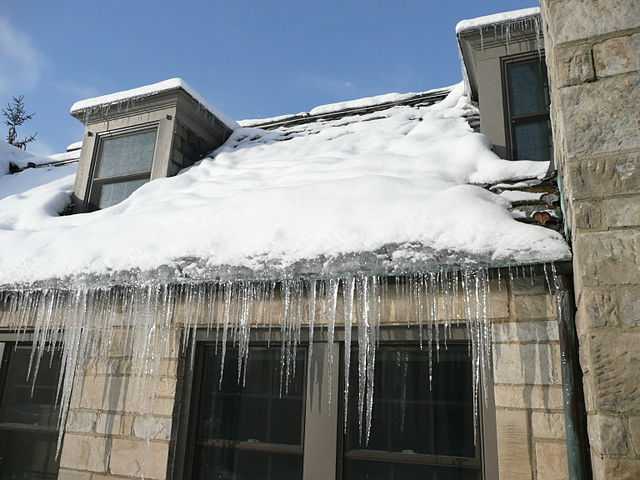Ice Dams 101: How They Occur and Ways to Stop Them

Do you spend those bitter winter months daydreaming about backyard barbecues, lounging by the pool, and enjoying sunkissed afternoons? I’m certain the last thing on your mind is ice damage to your home – especially those caused by ice dams.
Although they are most common in northern climates, ice dams can pose a threat to homes in any environment that experiences snowfall and cold weather, even in the spring. Here’s what you need to know about ice dams and how to prevent them.
What Are Ice Dams?
Ice dams are ridges of ice that form along the edges of your home’s roof. They create a “dam” effect, which prevents melting snow from trickling into your gutters. Instead, the water remains on your roof, which can cause serious consequences.
For starters, all of that water accumulates and can leak into your home. Roof leaks can lead to damage to your ceilings, walls, floors, and belongings. Moisture in the home can also lead to mold and mildew growth, which may impact your home’s air quality. Plus, you’ll need to have your roof cleaned or repaired to prevent future leaks.
How Do Ice Dams Occur?
When it snows, snow builds up all over and around your home. The snow may begin melting during the day; however, if temperatures drop at night, the melted snow will refreeze as ice. This melting-freezing cycle may occur over the course of several days, leading to additional ice build-up along the edges of your roof. This ice may also edge its way underneath the shingles, putting your home at risk.
In an ideal setting, the surface temperature of your roof will be higher toward the top (above 32 degrees) and colder toward the bottom (below 32 degrees). Accordingly, as snow on the warmer parts of your roof melts and makes its way toward the edge, it hits the colder part of the roof and refreezes.
This cycle repeats quickly, as the dam is fed by a constant barrage of melting snow. However, the dam is limited to areas that are below 32 degrees. For the warmer areas of the roof, the water will pool up and eventually find cracks and crevices in the roof since it has nowhere else to go.
How Climate Affects Ice Dams
You may be at a greater risk of ice dams compared to others, and climate has a lot to do with it.
For instance, states like New Jersey and Massachusetts tend to experience significantly more snowfall than Georgia or South Carolina. In Massachusetts, for example, the temperature may not rise above freezing for days! Additionally, on the days that it does get above freezing, temperatures are likely to drop quickly at night, making your roof more susceptible to ice dams.
Nevertheless, in warmer states like Georgia and South Carolina, ice dams remain a threat throughout the winter and spring, even though snowfall isn’t common. Overnight temperatures can drop well below freezing, even in April! If snow is in the forecast, fluctuating temperatures could increase the risk of an ice dam.
For “middle ground” states like Virginia, where snowfall is more frequent compared to southern states, but not as frigid as northern states, the risk of ice dams can increase in the spring. Virginia experiences frequent cold snaps in the spring before it warms up for good. If warm weather hits following a cold snap, the snow on a roof will quickly melt, then refreeze overnight to form ice dams. The same applies to Georgia and South Carolina.
Homeowners who live in any state where spring snow is a possibility should be aware of how ice dams form, as well as ice damming removal tips to help them avoid roof issues.
Ice Damming Removal and Quick Fixes
As a homeowner, it’s important to inspect your roof when it snows and in the days that follow. Additionally, it is critical to check for the presence of ice dams. If you see a ridge of ice along the bottom edge of your roof, you’ll want to put your ice damming removal hacks into practice as soon as possible.
First, keep your gutters clean and clear so that water can roll off your roof and away from your home. Ice dams may not form along the entire length of the gutter, which will offer a path for some of that water to exit your roof.
You may also want to invest in a snow removal tool. These long-handled snow “rakes” can help you keep snow on your roof to a minimum, which will reduce the amount of melted snow that can refreeze or puddle due to ice dams.
It’s also a good idea to seal any potential heat leaks in your home’s roof. This will ensure that your roof maintains an even, consistent temperature to reduce the potential for ice dams to form. The solution may be as simple as making sure that your roof is well insulated and that lights are properly sealed.
Spring is the perfect time to do a quick inspection and ensure your roof and gutters are in good condition. Contact the gutter experts at Ned Stevens Gutter Cleaning® today to schedule your ice dam fix.


